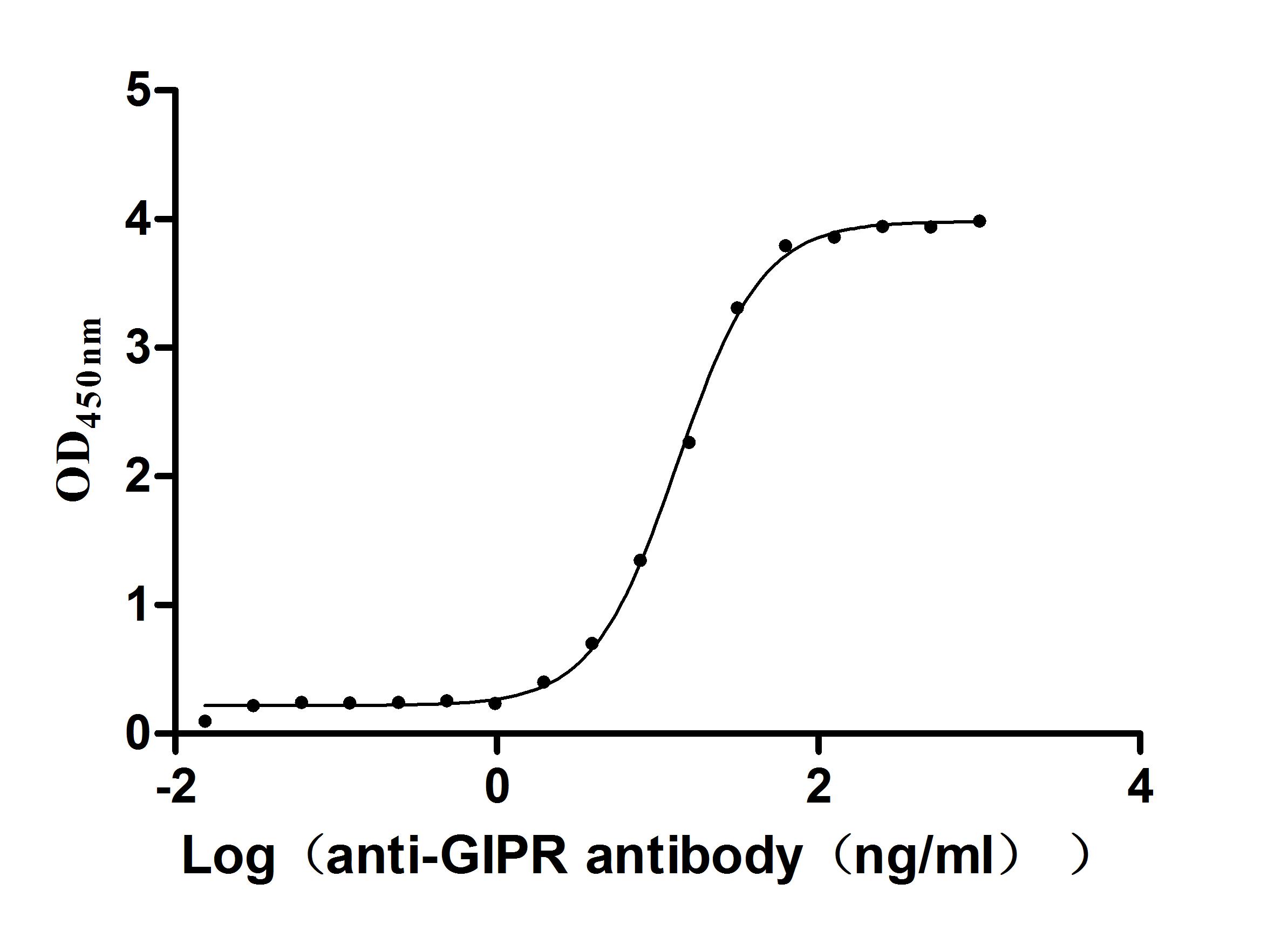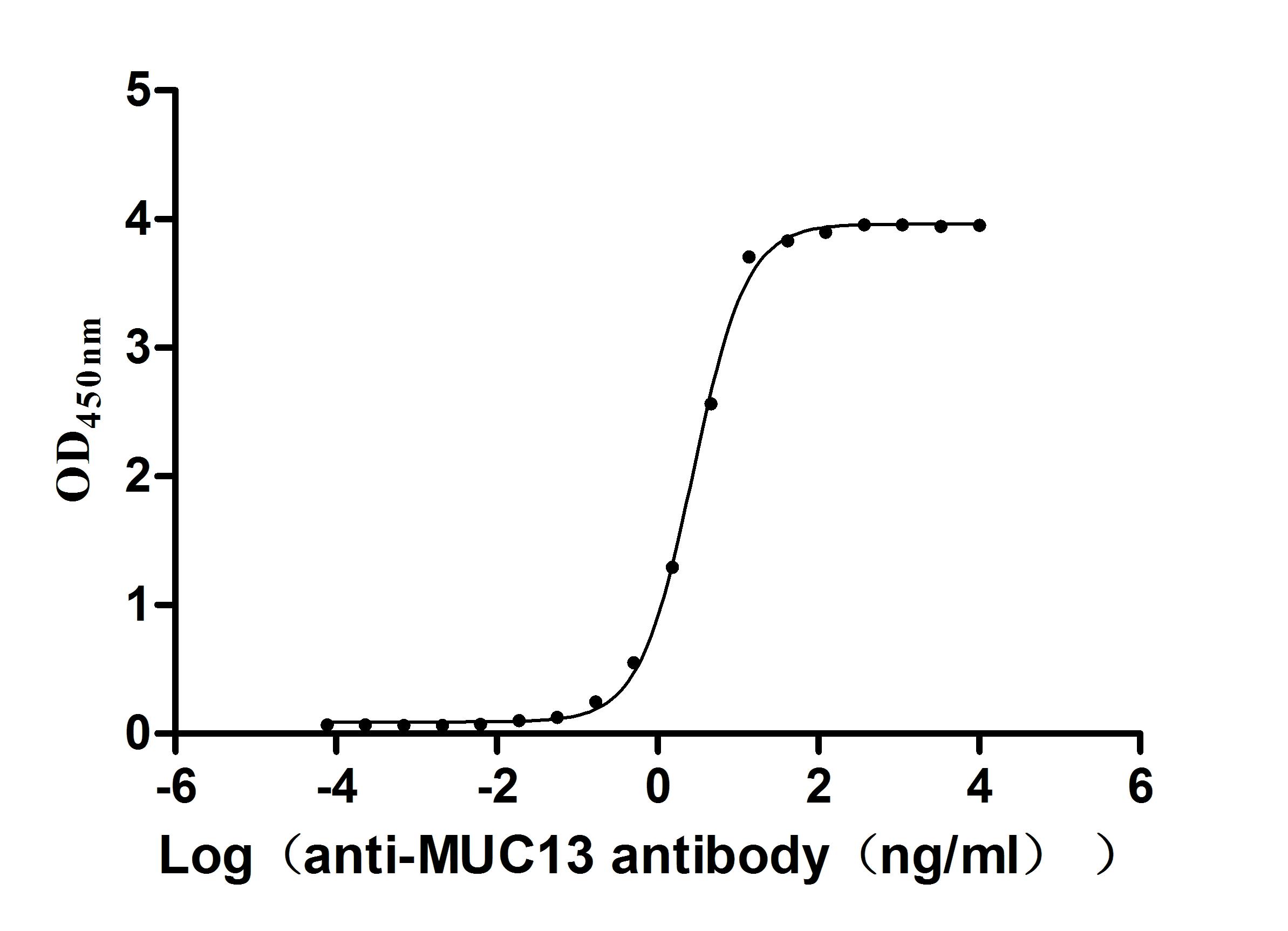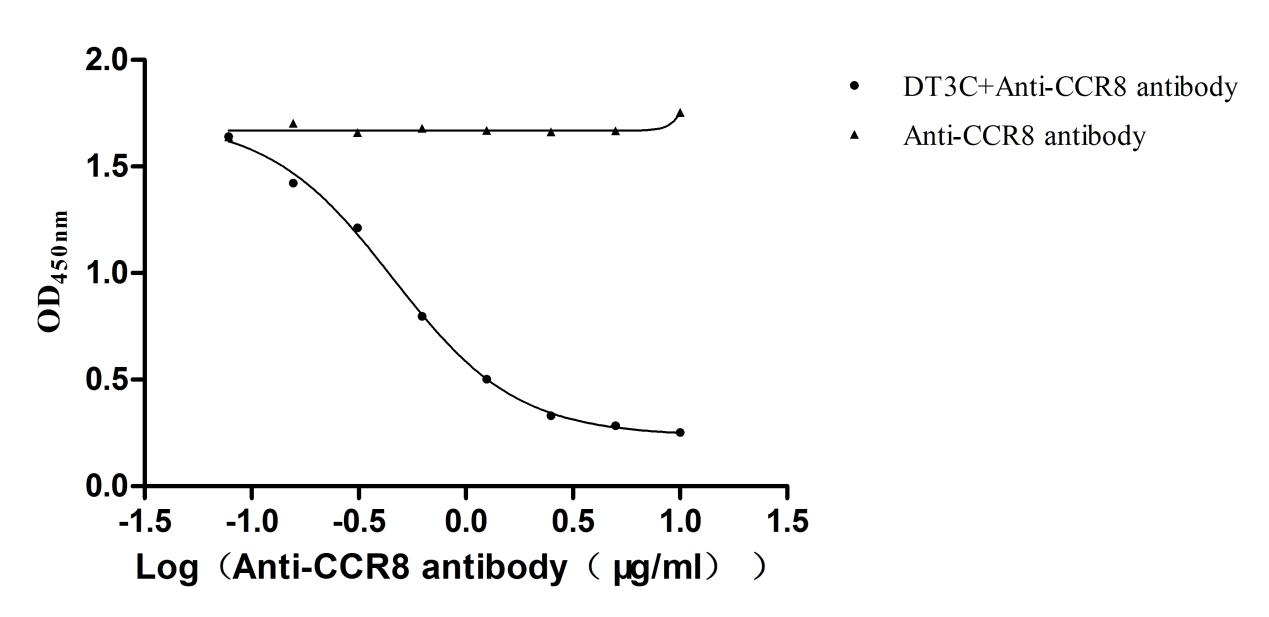Recombinant Human Proepiregulin (EREG)
-
货号:CSB-CF007779HU
-
规格:
-
来源:in vitro E.coli expression system
-
其他:
产品详情
-
基因名:
-
Uniprot No.:
-
别名:Epiregulin; EPR; ER ; Ereg; EREG_HUMAN; Proepiregulin
-
种属:Homo sapiens (Human)
-
蛋白长度:Full Length of Mature Protein
-
表达区域:30-169
-
氨基酸序列VLSTTVIPSCIPGESSDNCTALVQTEDNPRVAQVSITKCSSDMNGYCLHGQCIYLVDMSQNYCRCEVGYTGVRCEHFFLTVHQPLSKEYVALTVILIILFLITVVGSTYYFCRWYRNRKSKEPKKEYERVTSGDPELPQV
Note: The complete sequence including tag sequence, target protein sequence and linker sequence could be provided upon request. -
蛋白标签:10xHis-SUMO-tag
-
产品提供形式:Liquid or Lyophilized powder
Note: We will preferentially ship the format that we have in stock, however, if you have any special requirement for the format, please remark your requirement when placing the order, we will prepare according to your demand. -
缓冲液:Lyophilized from Tris/PBS-based buffer, 6% Trehalose, pH 8.0
-
储存条件:Store at -20°C/-80°C upon receipt, aliquoting is necessary for mutiple use. Avoid repeated freeze-thaw cycles.
-
保质期:The shelf life is related to many factors, storage state, buffer ingredients, storage temperature and the stability of the protein itself.
Generally, the shelf life of liquid form is 6 months at -20°C/-80°C. The shelf life of lyophilized form is 12 months at -20°C/-80°C. -
货期:Basically, we can dispatch the products out in 1-3 working days after receiving your orders. Delivery time may differ from different purchasing way or location, please kindly consult your local distributors for specific delivery time.Note: All of our proteins are default shipped with normal blue ice packs, if you request to ship with dry ice, please communicate with us in advance and extra fees will be charged.
-
注意事项:Repeated freezing and thawing is not recommended. Store working aliquots at 4°C for up to one week.
-
Datasheet & COA:Please contact us to get it.
相关产品
靶点详情
-
功能:Ligand of the EGF receptor/EGFR and ERBB4. Stimulates EGFR and ERBB4 tyrosine phosphorylation. Contributes to inflammation, wound healing, tissue repair, and oocyte maturation by regulating angiogenesis and vascular remodeling and by stimulating cell proliferation.
-
基因功能参考文献:
- in Caco-2 CFTR-shRNA cells, the EGFR ligand EREG is overexpressed due to an active IL-1beta autocrine loop that indirectly activates EGFR, constituting new signaling effectors for the CFTR signaling pathway, downstream of CFTR, Cl(-) , and IL-1beta. PMID: 29091309
- we showed that epidermal growth factor receptors (EGFR) were constitutively activated in metastatic lung subtypes of salivary adenoid cystic carcinoma cells, and that this activation was induced by autocrine expression of epiregulin PMID: 26958807
- Study shows how the EGFR ligands epiregulin (EREG) and epigen (EPGN) stabilize different dimeric conformations of the EGFR extracellular region. Results reveal how responses to different EGFR ligands are defined by receptor dimerization strength and signaling dynamics. These findings have broad implications for understanding receptor tyrosine kinase (RTK) signaling specificity. PMID: 28988771
- EREG and MMP-1 were found to be elevated in nasal polyp and uncinate tissues in patients with Chronic rhinosinusitis with nasal polyps. PMID: 28398769
- upregulation of EREG expression through promoter demethylation might be an important means of activating the EGFR pathway during the genesis of colorectal adenocarcinoma (CRC) and potentially other cancers. PMID: 27270421
- EREG and AREG are strongly regulated by methylation, and their expression is associated with CIMP status and primary tumour site. PMID: 27272216
- three-dimensional structure of the EPR antibody (the 9E5(Fab) fragment) in the presence and absence of EPR PMID: 26627827
- Together, these studies lead to identification of a novel pathway involving EREG and MMP-1 that contributes to the formation of early stage breast cancer PMID: 26215578
- These results suggested that EREG is one of the molecules involved in glioma malignancy PMID: 24470554
- Data indicate that the effects of epiregulin (EREG) and V-ATPase (TCIRG1) single nucleotide polymorphism (SNP) on pulmonary tuberculosis susceptibility, to the extent that they exist, are dependent on gene-gene interactions in West African populations. PMID: 24898387
- Patients homozygous for the minor allele A of EREG rs12641042 had a significantly higher 3-year survival rate than patients with allele C (HR 0.48; P=0.034), but significance was lost in multivariable analysis PMID: 25203737
- Epiregulin is a transcriptional target of TSC2 (tuberin). PMID: 24748662
- Epiregulin promotes the proliferation of liver progenitor cells and DNA synthesis by hepatocytes and is upregulated in the serum of patients with liver injury. PMID: 24812054
- Plasma HGF and EREG levels are associated with resistance to treatment with anti-EGFR antibodies in KRAS wild-type patients with metastatic colorectal cancer. PMID: 24800946
- Data suggest that EREG (epiregulin), AREG (amphiregulin), and BTC (betacellulin) induced prostaglandin E2 production by induction of COX-2 (prostaglandin-endoperoxide synthase 2) through MAP kinase signaling in granulosa cells. PMID: 24092824
- In pre-treated K-ras wild-type status colorectal cancer, patients with high EREG gene expression appear to benefit more from cetuximab therapy compared with low expression. PMID: 24335920
- EREG may contribute to glioma progression under the control of IRE1a. PMID: 24330607
- keratinocyte hyperproliferation in cholesteatoma is promoted through overexpression of epiregulin by subepithelial fibroblasts via epithelial-mesenchymal interactions, which may play a crucial role in the pathogenesis of middle ear cholesteatoma PMID: 23826119
- Depletion of Epiregulin with shRNA inhibited SCAP proliferation. PMID: 23829318
- Data indicate that epiregulin (EREG) expression significantly correlated with KRAS expression or KRAS copy number in KRAS-mutant non-small-cell lung cancer (NSCLC) cell lines. PMID: 22964644
- EREG-AREG and NRG1, which are members of the epidermal growth factor (EGF) family, seem to modulate Bhecet's Disease susceptibility through main effects and gene-gene interactions PMID: 23625463
- we did not find a correlation between the presence of a K-ras mutation and the presence of Epiregulin and Amphiregulin in colon cancer tissue. PMID: 23885463
- Apical mistrafficking of EREG crystallizes an apical EGFR signaling complex that may be uncoupled from basolateral regulatory restraints leading to cell transformation. PMID: 23671122
- FBXL11 inhibited osteo/dentinogenic differentiation potential in MSC cells by associating with BCOR, then increasing histone K4/36 methylation in Epiregulin promoter to repress Epiregulin transcription. PMID: 23074094
- EREG gene expression was low in 7 out of 11 gastric cancer cells and this downregulation was mediated by aberrant CpG methylation of the EREG promoter. PMID: 22508389
- Epiregulin (EREG) variation is associated with susceptibility to tuberculosis. PMID: 22170233
- Data suggest that expression status of AR and EPI mRNAs might be evaluated as dynamic predictors of response in KRAS WT patients receiving any cetuximab-based therapy. PMID: 21161326
- It is suggested that follow-up of the expression of Ep can serve as a reliable early indication of the development of ovarian cancer. PMID: 21769422
- Blockade of epiregulin reduced the growth of hTERT-BJ cells and colony formation of hTERT-transformed fibroblasts. Moreover, inhibition of epiregulin function in immortal hTERT-BJ cells triggered a senescence program. PMID: 12702554
- Epiregulin might be a more important tumor growth regulator of malignant fibrous histiocytoma through autocrine or paracrine pathways, when compared with betacellulin. PMID: 15274392
- upregulation of the epiregulin and amphiregulin expression is part of the signal transduction pathway which leads to ovulation and luteinization in the human ovary PMID: 15474502
- findings demonstrated that PGE2 may mimic LH action at least in part by the activation of amphiregulin and epiregulin biosynthesis in human granulosa cells PMID: 16888076
- epiregulin, COX2, and MMP1 and 2 collectively facilitate the assembly of new tumour blood vessels, the release of tumour cells into the circulation, and the breaching of lung capillaries by circulating tumour cells to seed pulmonary metastasis PMID: 17429393
- 1st report of EREG expression in breast cancer (45.5% of breast cancers studied). It is preferentially expressed in breast tumors co-expressing HER2/HER4. PMID: 17962208
- Epiregulin played an autocrine role in the proliferation of corneal epithelial cells presumably through cross-induction with other EGF family members. PMID: 18079685
- hamartomatous TSC skin tumors are induced by paracrine factors released by two-hit cells in the dermis, and proliferation with mTOR activation of the overlying epidermis is an effect of epiregulin PMID: 18292222
- Increased epiregulin is associated with oral squamous cell carcinomas PMID: 18497965
- Epiregulin has a protective effect against apoptosis in the human corpus luteum. PMID: 18835871
- The regulatory mechanism of epiregulin expression in Ki-ras-transformed 267B1 prostate epithelial cells was studied. PMID: 18948081
- Epiregulin expression correlates with advanced disease, is EGFR dependent, and confers invasive properties on non-small cell lung cancer cells. PMID: 19138957
显示更多
收起更多
-
亚细胞定位:[Epiregulin]: Secreted, extracellular space.; [Proepiregulin]: Cell membrane; Single-pass type I membrane protein.
-
组织特异性:In normal adults, expressed predominantly in the placenta and peripheral blood leukocytes. High levels were detected in carcinomas of the bladder, lung, kidney and colon.
-
数据库链接:
HGNC: 3443
OMIM: 602061
KEGG: hsa:2069
STRING: 9606.ENSP00000244869
UniGene: Hs.115263
Most popular with customers
-
Recombinant Human IGF-like family receptor 1 (IGFLR1), partial (Active)
Express system: Mammalian cell
Species: Homo sapiens (Human)
-
Recombinant Human Serine/threonine-protein kinase receptor R3 (ACVRL1), partial (Active)
Express system: Baculovirus
Species: Homo sapiens (Human)
-
Recombinant Macaca Gastric inhibitory polypeptide receptor(GIPR), partial (Active)
Express system: yeast
Species: Macaca fascicularis (Crab-eating macaque) (Cynomolgus monkey)
-
Recombinant Human Mucin-13(MUC13),partial (Active)
Express system: yeast
Species: Homo sapiens (Human)
-
Recombinant DT3C (Diphtheria toxin & spg 3C domain) for Antibody Internalization Assay (Active)
Express system: E.coli
Species: N/A

















